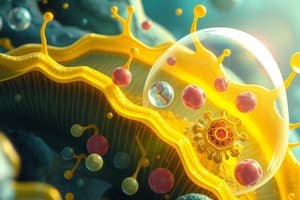Podcast
Questions and Answers
What is the primary function of the selective permeability of the cell membrane?
What is the primary function of the selective permeability of the cell membrane?
- To maintain the difference in composition between intracellular and extracellular materials (correct)
- To facilitate the transport of oxygen and carbon dioxide
- To produce energy for the cell through cellular respiration
- To regulate the temperature within the cell
Which of the following substances is NOT typically found at a higher concentration intracellularly?
Which of the following substances is NOT typically found at a higher concentration intracellularly?
- Sodium ions (correct)
- Potassium ions
- Glycogen
- Enzymes
What determines whether a molecule can pass through a cell membrane channel?
What determines whether a molecule can pass through a cell membrane channel?
- The size and shape of the molecule (correct)
- The charge and solubility of the molecule
- The pH of the extracellular environment
- The concentration of the molecule
What is the result of rupture or alteration of the cell membrane?
What is the result of rupture or alteration of the cell membrane?
How do lipid-soluble molecules pass through the cell membrane?
How do lipid-soluble molecules pass through the cell membrane?
What is the primary function of carrier molecules in the cell membrane?
What is the primary function of carrier molecules in the cell membrane?
What type of transport process requires a carrier molecule and energy to move substances against a concentration gradient?
What type of transport process requires a carrier molecule and energy to move substances against a concentration gradient?
What is the purpose of vesicles in the cell membrane?
What is the purpose of vesicles in the cell membrane?
What is the primary difference between extracellular and intracellular material?
What is the primary difference between extracellular and intracellular material?
What is the process of moving particles from a region of higher concentration to a region of lower concentration?
What is the process of moving particles from a region of higher concentration to a region of lower concentration?
Flashcards are hidden until you start studying
Study Notes
Cell Membrane Permeability
- The cell membrane is selectively permeable, allowing some substances to pass through while restricting others.
- The cell's survival depends on maintaining the difference between intracellular and extracellular material.
Concentration Gradient
- Substances like enzymes, glycogen, and potassium ions are found in higher concentrations inside the cell.
- Sodium, calcium, and chloride ions are found in greater concentrations outside the cell.
Mechanisms of Movement
- Molecules can pass through the cell membrane in four ways: directly through the phospholipid membrane, through membrane channels, via carrier molecules, and through vesicles.
- Simple diffusion is the movement of particles from a region of higher concentration to a region of lower concentration.
- Osmosis is the diffusion of solvent or water molecules through a selectively permeable membrane.
- Filtration utilizes pressure to push substances through a membrane.
- Active transport moves substances against a concentration gradient, requiring a carrier molecule and energy.
- Endocytosis refers to the formation of vesicles to transfer particles and droplets from outside the cell to inside.
Transport through Phospholipid Membrane
- Lipid-soluble molecules like oxygen, carbon dioxide, and steroids pass through the cell membrane readily.
- Small, non-lipid-soluble molecules like water and urea can diffuse between phospholipid molecules.
Membrane Channels
- Cell membrane channels are large protein molecules that allow certain molecules to pass through based on size, shape, and charge.
- Examples include sodium channels, potassium channels, and chloride channels.
Carrier Molecules
- Large polar molecules like glucose and amino acids are transported across the cell membrane by carrier molecules.
- Carrier molecules are proteins that extend from one side of the cell membrane to the other, binding to specific molecules to be transported.
- Each carrier molecule transports a specific type of molecule.
Vesicles
- Vesicles are membrane-bound sacs that can transport large non-lipid-soluble molecules, small pieces of matter, and even whole cells across the cell membrane.
- Vesicles can fuse with the cell membrane, allowing their contents to cross the cell membrane.
Studying That Suits You
Use AI to generate personalized quizzes and flashcards to suit your learning preferences.



